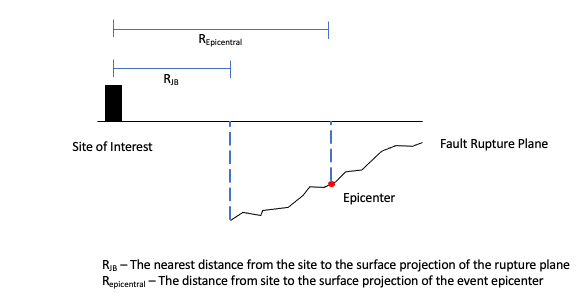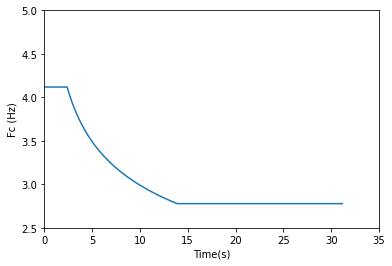Ground Motion Simulation
Calculates a ground acceleration history using a ground motion model written in a python script
Creates a realistic ground motion simulation with given input parameters. The object generates a time-acceleration history using the process outlined in Sabetta et al. (2021). The required function inputs M,R,and Vs30 correspond to the earthquake magnitide, source-to-site distance, and shear wave velocity at a depth of 30m, respectively. F, R_type and n are optional parameters that correspond to the style of faulting, the type of source-to-site distance being used and the random seed to be used. The Magnitude of an event is a measure of its strength, the source-to-site distance is how far from the event we are interested in estimating the ground acceleration at, Vs30 is a soil property that describes the propogation of waves through the soil. There are 3 distinct fault types that can be specified in the function: Strike-Slip, Thrust Fault, and Normal Fault denoted as 'SS', 'TF', and 'NF'. The source-to-site distance can be defined in one of two ways, either as Joyner-Boore distance or Epicentral distance which can be input as 'Rjb' and 'Repi'. The code block below shows the distinction between these two commonly used distance measurements. The function values return in units of (g), so the scale_factor by default is set to 9.81
[Functions<<<{"href": "../../syntax/Functions/index.html"}>>>]
[groundmotion]
type = GroundMotionSim<<<{"description": "Calculates a ground acceleration history using a ground motion model written in a python script", "href": "GroundMotionSim.html"}>>>
M<<<{"description": "Magnitude of Event"}>>> = 7.1
R<<<{"description": "Joyner-Boore or Epicentral Distance"}>>> = 10
Vs30<<<{"description": "Shear Wave Velocity at 30m"}>>> = 300
n<<<{"description": "Random Seed"}>>> = 0
[]
[]
(test/tests/functions/ground_motion_sim/ground_motion_sim.i)
Figure 1: Source-to-site distance measurements
Figure 2 shows simulated ground motion generated from the set of inputs in the above Function block. Varying the seed may provide slightly different results due to the randomly generated phase angles that are used to formulate the time-history, but the frequency domain for a set of inputs remains the same. The central frequency vs time is shown in Figure 3
Figure 2: Time series of a sample ground motion

Figure 3: Central Frequency over Time Domain
(test/tests/functions/ground_motion_sim/ground_motion_sim.i)
[Mesh]
type = GeneratedMesh
dim = 1
[]
[Variables]
[u]
[]
[]
[Functions]
[groundmotion]
type = GroundMotionSim
M = 7.1
R = 10
Vs30 = 300
n = 0
[]
[]
[Postprocessors]
[func]
type = FunctionValuePostprocessor
function = groundmotion
execute_on = "INITIAL TIMESTEP_END"
[]
[]
[Problem]
type = FEProblem
solve = false
kernel_coverage_check = false
[]
[Executioner]
type = Transient
num_steps = 5000
dt = 0.005
[]
[Outputs]
csv = true
[]
(test/tests/functions/ground_motion_sim/ground_motion_sim.i)
[Mesh]
type = GeneratedMesh
dim = 1
[]
[Variables]
[u]
[]
[]
[Functions]
[groundmotion]
type = GroundMotionSim
M = 7.1
R = 10
Vs30 = 300
n = 0
[]
[]
[Postprocessors]
[func]
type = FunctionValuePostprocessor
function = groundmotion
execute_on = "INITIAL TIMESTEP_END"
[]
[]
[Problem]
type = FEProblem
solve = false
kernel_coverage_check = false
[]
[Executioner]
type = Transient
num_steps = 5000
dt = 0.005
[]
[Outputs]
csv = true
[]
(examples/ex15/TankUQ_mod.i)
[Mesh]
[file]
type = FileMeshGenerator
file = Vessel_NoIsolator_Coarse.e
[]
[interface1]
type = SideSetsBetweenSubdomainsGenerator
input = file
primary_block = '2'
paired_block = '1'
new_boundary = 'Interface'
[]
[]
[GlobalParams]
[]
[Variables]
[p]
block = 2
[]
[disp_x]
block = 1
[]
[disp_y]
block = 1
[]
[disp_z]
block = 1
[]
[]
[AuxVariables]
[Wave1]
block = 2
[]
[vel_x]
order = FIRST
family = LAGRANGE
block = 1
[]
[accel_x]
order = FIRST
family = LAGRANGE
block = 1
[]
[vel_y]
order = FIRST
family = LAGRANGE
block = 1
[]
[accel_y]
order = FIRST
family = LAGRANGE
block = 1
[]
[vel_z]
order = FIRST
family = LAGRANGE
block = 1
[]
[accel_z]
order = FIRST
family = LAGRANGE
block = 1
[]
[stress_xx]
order = CONSTANT
family = MONOMIAL
block = 1
[]
[stress_yy]
order = CONSTANT
family = MONOMIAL
block = 1
[]
[stress_xy]
order = CONSTANT
family = MONOMIAL
block = 1
[]
[stress_zz]
order = CONSTANT
family = MONOMIAL
block = 1
[]
[stress_yz]
order = CONSTANT
family = MONOMIAL
block = 1
[]
[stress_xz]
order = CONSTANT
family = MONOMIAL
block = 1
[]
[]
[Kernels]
[diffusion]
type = Diffusion
variable = 'p'
block = 2
[]
[inertia]
type = AcousticInertia
variable = p
block = 2
[]
[DynamicTensorMechanics]
displacements = 'disp_x disp_y disp_z'
block = 1
[]
[inertia_x1]
type = InertialForce
variable = disp_x
block = 1
[]
[inertia_y1]
type = InertialForce
variable = disp_y
block = 1
[]
[inertia_z1]
type = InertialForce
variable = disp_z
block = 1
[]
[]
[AuxKernels]
[waves]
type = WaveHeightAuxKernel
variable = 'Wave1'
pressure = p
density = 1e-6
gravity = 9.81
execute_on = timestep_end
block = 2
[]
[accel_x]
type = TestNewmarkTI
displacement = disp_x
variable = accel_x
first = false
block = 1
[]
[vel_x]
type = TestNewmarkTI
displacement = disp_x
variable = vel_x
block = 1
[]
[accel_y]
type = TestNewmarkTI
displacement = disp_y
variable = accel_y
first = false
block = 1
[]
[vel_y]
type = TestNewmarkTI
displacement = disp_y
variable = vel_y
block = 1
[]
[accel_z]
type = TestNewmarkTI
displacement = disp_z
variable = accel_z
first = false
block = 1
[]
[vel_z]
type = TestNewmarkTI
displacement = disp_z
variable = vel_z
block = 1
[]
[stress_xx]
type = RankTwoAux
rank_two_tensor = stress
variable = stress_xx
index_i = 0
index_j = 0
block = 1
[]
[stress_yy]
type = RankTwoAux
rank_two_tensor = stress
variable = stress_yy
index_i = 1
index_j = 1
block = 1
[]
[stress_xy]
type = RankTwoAux
rank_two_tensor = stress
variable = stress_xy
index_i = 0
index_j = 1
block = 1
[]
[stress_zz]
type = RankTwoAux
rank_two_tensor = stress
variable = stress_zz
index_i = 2
index_j = 2
block = 1
[]
[stress_yz]
type = RankTwoAux
rank_two_tensor = stress
variable = stress_yz
index_i = 1
index_j = 2
block = 1
[]
[stress_xz]
type = RankTwoAux
rank_two_tensor = stress
variable = stress_xz
index_i = 0
index_j = 2
block = 1
[]
[]
[InterfaceKernels]
[interface1]
type = StructureAcousticInterface
variable = p
neighbor_var = disp_x
boundary = 'Interface'
D = 1e-6
component = 0
[]
[interface2]
type = StructureAcousticInterface
variable = p
neighbor_var = disp_y
boundary = 'Interface'
D = 1e-6
component = 1
[]
[interface3]
type = StructureAcousticInterface
variable = p
neighbor_var = disp_z
boundary = 'Interface'
D = 1e-6
component = 2
[]
[]
[BCs]
[top_accel1]
type = PresetAcceleration
variable = disp_x
velocity = vel_x
acceleration = accel_x
beta = 0.25
function = groundmotion
boundary = 'Top'
[]
[disp_x2]
type = DirichletBC
variable = disp_y
boundary = 'Top'
value = 0.0
[]
[disp_x3]
type = DirichletBC
variable = disp_z
boundary = 'Top'
value = 0.0
[]
[free]
type = FluidFreeSurfaceBC
variable = p
boundary = 'Fluid_top'
alpha = '0.1'
[]
[]
[Functions]
[groundmotion]
type = GroundMotionSim
M = 0
R = 0
Vs30 = 0
F = 'SS'
n = 0
execute_on = INITIAL
[]
[]
[Materials]
[density]
type = GenericConstantMaterial
prop_names = inv_co_sq
prop_values = 4.65e-7
block = 2
[]
[density0]
type = GenericConstantMaterial
block = 1
prop_names = density
prop_values = 7.85e-6
[]
[elasticity_base]
type = ComputeIsotropicElasticityTensor
youngs_modulus = 2e2
poissons_ratio = 0.27
block = 1
[]
[strain]
type = ComputeFiniteStrain
block = 1
displacements = 'disp_x disp_y disp_z'
[]
[stress]
type = ComputeFiniteStrainElasticStress
block = 1
[]
[]
[Preconditioning]
[andy]
type = SMP
full = true
[]
[]
[Executioner]
type = Transient
solve_type = 'NEWTON'
petsc_options_iname = '-pc_type -pc_factor_mat_solver_package'
petsc_options_value = 'lu superlu_dist'
start_time = 0.0
end_time = 10.0
dt = 0.005
dtmin = 0.001
nl_abs_tol = 1e-14
nl_rel_tol = 1e-14
l_tol = 1e-14
l_max_its = 25
timestep_tolerance = 1e-8
automatic_scaling = true
[TimeIntegrator]
type = NewmarkBeta
[]
[]
[Controls]
[stochastic]
type = SamplerReceiver
[]
[]
[Postprocessors]
[PSide]
type = PointValue
point = '2.412779 -0.425438 0.050000'
variable = p
[]
[Wave]
type = PointValue
point = '2.450000 0.000000 5.050000'
variable = Wave1
[]
[DispBottom]
type = PointValue
point = '2.462019 0.434120 0.000'
variable = disp_x
[]
[AccBottom]
type = PointValue
point = '2.462019 0.434120 0.000'
variable = accel_x
[]
[PeakDisp]
type = TimeExtremeValue
postprocessor = DispBottom
output_type = extreme_value
[]
[PeakAcc]
type = TimeExtremeValue
postprocessor = AccBottom
output_type = extreme_value
[]
[PeakPressure]
type = TimeExtremeValue
postprocessor = PSide
output_type = extreme_value
[]
[PeakWaveHeight]
type = TimeExtremeValue
postprocessor = Wave
output_type = extreme_value
[]
[AppliedAcc]
type = FunctionValuePostprocessor
function = groundmotion
[]
[]
[VectorPostprocessors]
[accel_hist]
type = ResponseHistoryBuilder
variables = 'accel_x'
nodes = '578'
block = 1
[]
[accel_spec]
type = ResponseSpectraCalculator
vectorpostprocessor = accel_hist
regularize_dt = 0.005
outputs = out
[]
[]
[Outputs]
[accout]
type = CSV
show = 'AppliedAcc PSide Wave DispBottom AccBottom'
[]
[out]
type = CSV
execute_on = FINAL
[]
[]

